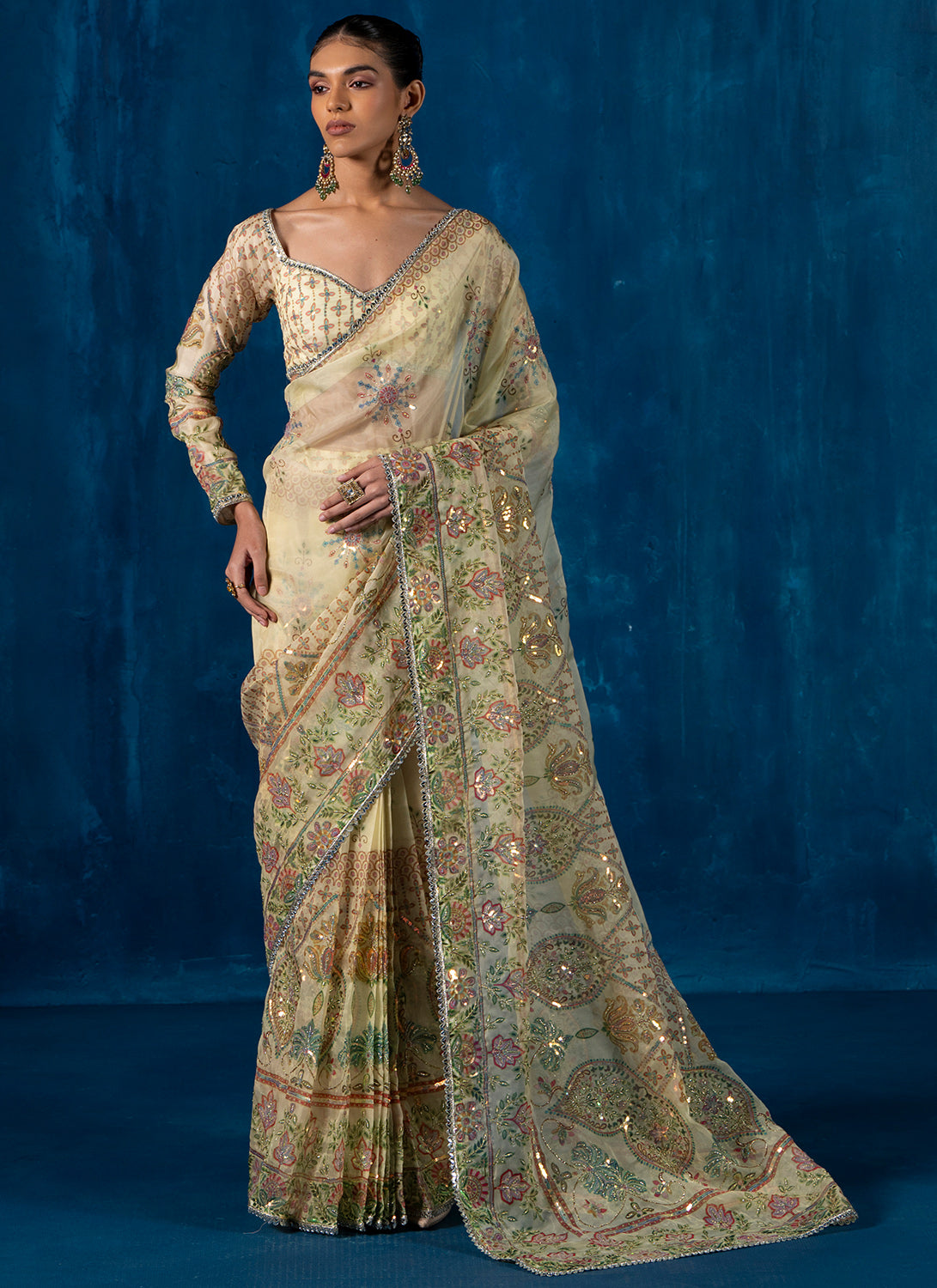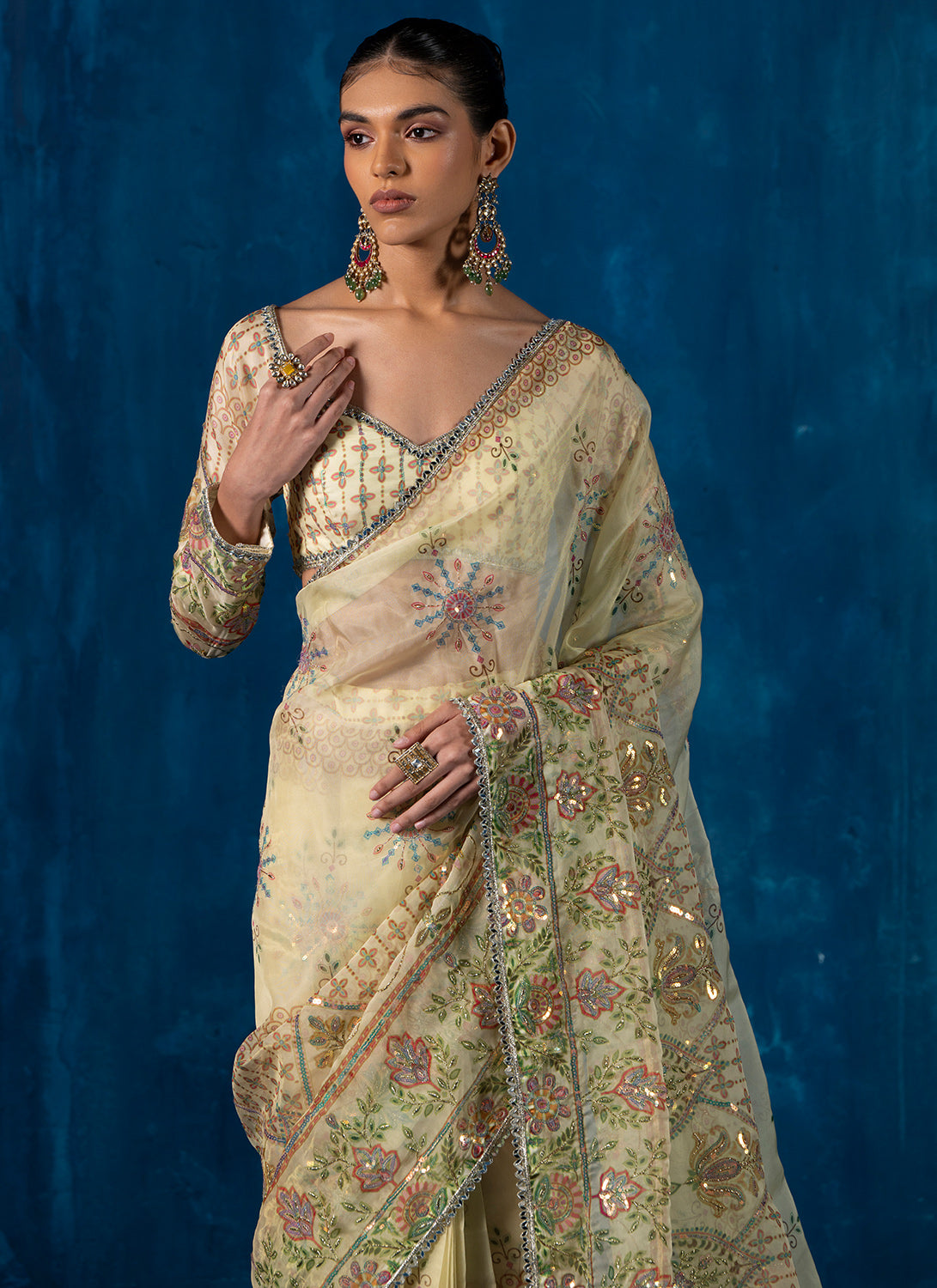Sarees, the quintessential attire of South Asian women, encapsulate a rich tapestry of culture, tradition, and craftsmanship. Originating from the Indian subcontinent, the saree has evolved over centuries, reflecting diverse regional influences and artistic expressions.
But no matter the fabric or draping style, one key detail always matters: the length of the saree. This iconic garment, typically a length of fabric ranging from five to nine yards, is draped elegantly around the body, offering versatility in style and occasion.
Whether you’re a seasoned saree lover or shopping for your first piece online, understanding saree length is essential to finding the perfect fit. In this guide, we’ll explore standard saree measurements, variations across fabrics and regions, how to measure one at home, and why tailoring matters — all while spotlighting some gorgeous examples from Lashkaraa’s Designer Sarees.
What is A Saree: Regional Variations & Evolution
The saree, alternatively spelt as a "sari," has been a part of the cultural attire for Indian women across centuries. A staple in Indian fashion, it’s a fabulous, versatile piece of cloth that transforms its wearer into a vision of grace and style.
Every region in India has contributed to the evolution of the saree. In Bengal, women drape their sarees with a deep front pallu, known as the loose end, and structured pleats — ideal for humid weather and daily wear. Gujarati women traditionally wear the saree with a seedha pallu that’s brought over the right shoulder to the front, often to display intricate embroidery. Across Maharashtra, the Nauvari saree is worn in a dhoti-like wrap for ease of movement and function.
These styles continue to evolve. Today’s sarees are worn for more rituals or festivals, and have been reimagined for contemporary wear, destination weddings, and even red-carpet events. New-age draping techniques, pre-stitched styles, and experimentation with cholis or Indian blouse styles make sarees as modern as they are rooted in culture.
Standard Saree Length vs. Short Saree
The most commonly worn sarees measure between 5.5 to 6 yards long, which is about 5 to 5.5 meters or roughly 18 feet. This length offers enough fabric for the essential pleats around the waist and a flowing pallu. It also allows for flexible styling — from the classic Nivi drape to more experimental, fusion styles.
Standard sarees typically come with a 0.8-meter saree blouse piece attached to one end. When shopping online, this is usually noted in the product details. It’s important to remember that this blouse fabric isn’t part of the draping length, so your total saree might measure close to 6.5 meters, including the blouse piece.
Short sarees, typically around 5.5 to 6 yards, offer ease and are great for casual wear. Longer sarees, on the other hand, exceeding 6 yards, provide an elegant drape, perfect for formal events or traditional looks.
How to Measure a Saree at Home
Measuring a saree at home is simple. Start by laying the saree flat on a clean surface. Use a measuring tape to stretch from one end to the other.
Saree Length: The total length should fall between 5.5 and 6.5 meters. If the saree includes a blouse piece, this section will usually be marked by a change in color, pattern, or texture, and is most often stitched at one end of the saree.
Saree Width: Width is another important factor. Most sarees are about 44 to 48 inches wide. This affects how the pleats sit on the body and how much pallu coverage you get. A wider saree gives more generous pleats, while a narrower one results in a slimmer, more contemporary look.
If buying online, always refer to the size chart or product specs. Lashkaraa sarees list both the saree length and blouse fabric measurements to make selection easier.
Saree Styles by Indian Regions and Designers
Not all sarees are created equal in length or drape. Cultural traditions, fabric types, and designer elements and motifs influence these variations.
In Maharashtra, the Nauvari saree extends to about 9 yards. This extra length allows it to be worn like a dhoti, traditionally without a petticoat. In contrast, a standard Bengali saree sticks to 6 yards but relies heavily on pleating and pallu arrangement for its distinctive look. Similarly, the Gujarati seedha pallu saree uses the same length as a regular saree but is styled front-facing to show off its embroidery.
Fabric affects not just how the saree looks but also how much you may need. For instance, a stiff cotton saree, like Chanderi or Bengal handloom, needs careful pleating and is best worn in its full 6-yard form. With a delicate georgette fabric, this Soft Green Embroidered Georgette Saree, flows effortlessly and can drape beautifully even in lighter lengths. The same goes for chiffon, crepe, and satin, which are preferred for contemporary, weightless looks.
Some designer sarees are pre-pleated or come with jackets and structured blouses, like the Red Embroidered Jacket Style Saree. This piece blends modern tailoring with traditional design, making it an ideal choice for receptions or parties. These types often maintain standard length but introduce new silhouettes, making them perfect for those looking for statement fashion.
For those who love romantic floral styles, Lashkaraa’s Off White Multicolor Floral Printed Saree offers a breezy, printed version of the saree. Its length remains classic, but its fluid fabric and pastel palette make it perfect for day events and summer weddings.
Sarees crafted in brocade, such as the Purple Embroidered Brocade Saree, are structured and often need extra volume in the pleats or pallu to carry the fabric’s richness. These styles are timeless and work best when worn with full-length coverage to show off the woven detail and embroidery.
Saree Fabrics
Sarees are like a fashion fiesta with a fabric carnival! Picture silk sarees as the dazzling showstoppers, from Banarasi drama to Kanjeevaram elegance, each with its intricate dance of patterns. Regional flavors spice up the saree game. Different parts of India bring a unique touch, weaving stories into the fabric. It's like a fashion geography lesson, but way more entertaining.
Cotton sarees are the everyday heroes, keeping it cool with Chanderi, Gadwal, and Kota weaving comfort into style.
Chiffon and georgette sarees are the light and breezy party-goers, always ready to twirl with delicate embroidery or quirky prints.
Crepe sarees bring the cool crinkle vibes to the fashion bash, while linen sarees strut their casual chic in earthy tones.
Net sarees are the red carpet stunners, sheer and fabulous, bedazzled with intricate bling.
Satin and velvet sarees bring the glam, ready to paint the town in rich colors and luxurious textures.
Finally, organza sarees like the Light Yellow Embroidered Organza Saree, featuring elaborate zari, sequins, and handwork embellishments, are having their very own contemporary moment.
Tailoring a Saree for the Perfect Fit
The beauty of a saree lies in its customizability. While the drape remains untouched, tailoring your blouse and petticoat can transform how the saree fits and feels. A well-fitted blouse brings structure to the look and lets the saree shine. You can experiment with sleeve lengths, necklines, back cuts, and even embellishments.
Some sarees, especially designer, can be stitched with pre-pleated drapes or structured blouses, like jacket style sarees. Tailoring these pieces to your proportions ensures comfort and confidence, especially during long events.
How to Wear A Saree
Learning how to wear a saree is like crafting your own stylish masterpiece in itself! Think of the saree as a canvas for creativity – a playground of colors, patterns, and textures. Whether it's the regal silk, the breezy cotton, or the flirtatious chiffon, sarees come in more varieties than your favorite ice cream parlor.
The charm of a perfect saree lies in its draping style. Whether it's the classic Nivi drape or the modern Gujarati style, mastering the art of saree draping is an essential skill. One of the most crucial elements in achieving a perfect saree drape is the pallu, as it significantly influences the overall appearance. Contrary to popular belief, it's advisable to secure the loose end (pallu) first rather than focusing on tucking the tummy pleats initially.
This approach allows for better control over the remaining portion of the saree, which can then be elegantly styled around the tummy pleats. Tuck, pleat, and voila - you've got the front flare! Add some accessories to dress up, and you're ready to own the traditional chic look.
If your saree features key designs on the pallu like the gracious Blue Embroidered Brocade Saree, opting for a flaring pallu that extends gracefully low is essential to showcase these designs beautifully.
Additionally, when wearing a saree adorned with border work, say the Purple Embroidered Brocade Saree, pleating the pallu can enhance the richness near the face, with the length of the pleated pallu ideally reaching just till the knee.
Pleated pallu variations offer versatility, allowing you to experiment with different arrangements of the bottom pleats, such as lining them at the same level for a vintage look or opting for a trendy zig-zag pattern. Remember to secure the pallu on the shoulder with pins for both styles, ensuring a secure hold.
For a cleaner appearance at the front, consider pinning the pallu onto the belt of the blouse once it's arranged, preventing any slipping and providing a stable, hassle-free look that doesn't require constant readjustment.
History of Sarees
The history of sarees is rich and diverse, with each region contributing to the evolution of this iconic attire. Sarees have a rich history, originating in the Indian subcontinent and mentioned in ancient texts like the Vedas and Mahabharata. The term "saree" comes from the Sanskrit word "sati," reflecting its early presence in traditional attire.
Beyond just clothing, sarees symbolized social and cultural identity, with diverse draping styles across regions. Each saree color has a meaning of significance. Over time, various weaving techniques, dyeing methods, and embroidery styles emerged, giving rise to silk sarees like Banarasi and Kanjeevaram for special occasions and cotton sarees from Bengal and South India for everyday wear.
During the Mughal era, the influence of Persian aesthetics brought about changes in saree draping styles and introduced intricate designs. The British colonial period witnessed the commercialization of the handloom industry, impacting traditional weaving practices. The Black Velvet Sequins Embroidered Saree, for instance, is an eye-catching piece crafted in velvet with zari, sequins and stone embroidery.
In the 20th century, the saree evolved further with the advent of synthetic fabrics and modern design influences. The garment became a canvas for experimentation, blending traditional craftsmanship with contemporary styles. If your wardrobe is missing the refreshing touch of modernity, then we suggest you invest in an Ombre ruffled chiffon saree like this one, as it has what it takes to make you look fabulous without compromising on comfort.
Find Your Perfect Saree at Lashkaraa
No matter the occasion — a sunlit mehendi, a temple wedding, or an elegant evening party — Lashkaraa has a saree to match your moment. Our sarees are thoughtfully designed with attention to detail, from the fabric quality to the finish of embroidery and cut. Whether you want to stick to tradition or try something modern, you’ll find a drape that feels just right.
Explore the Lashkaraa new arrivals online and discover the style made for you.

Sources:
2025 Style: What is the significance of the Pallu? | Tia Bhuva
The Timeless Beauty of Maharashtra Sarees | Trend Oye
Draped in Legacy: Gujarat’s Influential Seedha Pallu Style | First Look
The Luminous Legacy of Kota Doria | Frontier Raas
Costumes of Mughal Era | Textile Value Chain












